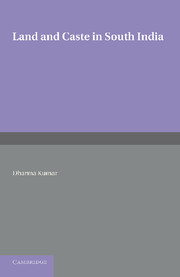 Land and Caste in South India
Land and Caste in South India Book contents
- Frontmatter
- Dedication
- CONTENTS
- List of Tables and Figures
- Acknowledgements and A Note on Certain Connventions
- Abbreviations
- Map of the Madras Presidency
- PART I
- PART II
- VII LAND AND POPULATION
- VIII EMIGRATION
- IX WAGES
- X THE GROWTH OF AGRICULTURAL LABOUR FROM 1871 TO 1901
- XI CONCLUSION
- Glossary
- Bibliography
- Index
- Frontmatter
- Dedication
- CONTENTS
- List of Tables and Figures
- Acknowledgements and A Note on Certain Connventions
- Abbreviations
- Map of the Madras Presidency
- PART I
- PART II
- VII LAND AND POPULATION
- VIII EMIGRATION
- IX WAGES
- X THE GROWTH OF AGRICULTURAL LABOUR FROM 1871 TO 1901
- XI CONCLUSION
- Glossary
- Bibliography
- Index
Summary
On the basis of the available date on land utilization and population alone it is not possible to say definitely whether or not the acreage under crops —taking into account not only the extension of cultivation to new lands but also more intensive cultivation of the old—increased at a faster rate than the growth in the numbers dependent on agriculture. Since direct evidence on the point is insufficient, recourse must be had to other evidence, of which the most important is wages. Changes in the land-labour ratio can be inferred to some extent from wage movements: a fall in wages would support the presumption that the land-labour ratio was decreasing, in other words that the extension of cultivation was insufficient to meet the growth of the labour force in agriculture. Over the first half of the nineteenth century population grew substantially, though probably not at the recorded rate of 130 per cent. It seems probable that there was hardly any significant extension of the area under cultivation over the same period—a drastic decline in cultivation up to 1825 or so being offset by substantial increases in the next two decades. Unfortunately, it is just for this period, when data on population and land utilization are most scanty, that wage data are also most defective: the few scattered wage quotations cannot be used to induce trends within the period, and can at best serve only as a basis for comparison with later wage quotations.
For the second half of the century, and particularly for the last quarter, the position is easier. From the figures of land under cultivation it would not appear that the extension of cultivation greatly exceeded the growth of the labour force in agriculture; it may well have fallen short of it if inferior lands were taken under cultivation. This latter presumption is strengthened by the wage data which show a falling trend: wages series for seven districts show that for all of them, except Tanjore, wages were lower at the end of the century than in 1873.
The wage data also throw light on the monetization of the economy. At the beginning of the nineteenth century it is clear that the wages of both attached and casual labourers were generally paid in grain, apart from perquisites in the form of clothes and money.
- Type
- Chapter
- Information
- Land and Caste in South IndiaAgricultural Labour in the Madras Presidency during the Nineteenth Century, pp. 144 - 167Publisher: Cambridge University PressPrint publication year: 2013


